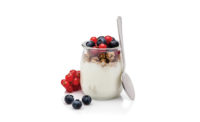We dusted off the jukebox to play the songs that best represent dairy foods and beverages. Our annual State of the Dairy Industry report examines the prospects for all dairy categories. Hit the play button on ‘Sugar Sugar’ as we discuss all the happenings in the ingredients category.
As a rule, dairy processors are a no-nonsense lot. An ingredient’s strongest selling point often boils down to how well it fits the product, the process and the price target. But attend any trade expo or read any industry publication and you’ll see that when it comes to selling innovative ingredients these days, good-old nuts-and-bolts functionality no longer closes the deal.
That’s because an ingredient’s job description has to stretch beyond what it does in a formulation. You might need it to assuage a label-reader’s anxieties, or meet new nutritional guidelines, or add value to outputs you might otherwise have dumped down the drain.
And that’s why the standout innovations of 2014 aren’t just about ingredients. They rope in the processes, technologies and out-of-the-box thinking that suppliers adopt every time they offer a new “solution” to a current challenge. With challenges ranging from transparency and sustainability to food waste, smart sugars and the public’s enchantment with all things “natural,” today’s ingredient innovations had better work hard. As luck would have it, we found a handful that do.
Waste not, want not
One example is a new technology that addresses the dirty little secret behind the biggest phenomenon to hit dairy since pasteurization: Greek-style yogurt. What do you do with the roughly 66 pounds of acid whey that remain after 100 pounds of milk become Greek yogurt?
Arla Foods Ingredients, Aarhus, Denmark, developed a combination process-plus-product that uses a specially developed dairy protein to transform acid whey into value-added dairy products—not only solving the disposal problem, but letting processors create new high-margin dairy applications rich in the quality whey protein that consumers crave. The innovation started earning accolades last year and continued into this one. Arla received a 2014 IFT Food Expo Innovation Award at IFT’s annual meeting in June.
Torben Jensen, an Arla application manager, said he “knew from the beginning that we had to develop a very specific protein that could withstand the low pH conditions of acid whey and remain stable during heat treatment.”
Arla also knew that the protein had to give processors a viable starting point for further application development. So they ensured that it would “neutralize” acid whey’s off taste and increase the protein level “up to around that of a drinking yogurt,” Jensen said.
“So in the end you might use the finished product itself as a beverage, or make it the base for a drinkable yogurt or even a cream cheese. You can use it to make desserts—It lets you produce a variety of dairy products.”
And in so doing, it turns what had been an operational liability into profit potential.
Algae-powered protein
The acid-whey story illustrates how a pressing resource challenge — food waste — can dovetail with a hot consumer trend. A similar narrative plays out with respect to the rising global demand for protein, and the pressure that puts on industry to cultivate new sources with which to satisfy it.
To wit, the worldwide market for protein is likely to hit $24.5 billion in 2015, with ingredients derived from plants accounting for the bulk of that growth. Sally Aaron, director of product marketing – nutrition, at Solazyme Inc. in South San Francisco, Calif., has watched the public’s preferences for protein evolve, and she knows this is a category primed for innovation.
“Consumers associate protein with satiety, weight loss and maintenance, and energy management,” Aaron said. “As weight management and energy continue to be high needs for consumers, the food industry is responding by offering a more diverse set of foods fortified or made with a variety of proteins, including alternative sources of vegan, nonallergenic proteins. As the world continues to grow, we need to find new, sustainable sources of protein to feed our planet.”
The focus of Solazyme’s efforts is both one of the newest proteins to hit the market and one of the oldest on earth: microalgae.
“Microalgae is the predecessor to most plant life,” Aaron explained, “containing a complete whole-food ecosystem in each cell. Rich in oil, macronutrients and micronutrients, microalgae has the potential to deliver a new source of protein that’s better for our health and our planet.”
Her company harnessed microalgae’s potential in AlgaVia, a whole algal protein that debuted at this year’s IFT Food Expo. The company produces it by inoculating a nutrient-rich broth with select microalgae and carefully controlling the environmental conditions — pH, temperature, oxygenation, agitation — and subsequent fermentation. The result is a fermentate that’s harvested, concentrated and dried into a vegan protein powder rich in essential amino acids and free of both gluten and known allergens.
And though the protein is highly digestible with a PDCAAS (protein-digestibility corrected amino acid score) of 0.51, it accounts for just 65% of the powder’s composition — implying that there’s more in there than pure protein. And indeed, Aaron said, because the powder is a “whole-food ingredient,” it’s also “a unique source of fiber, healthy lipids and micronutrients such as lutein and zeaxanthin.”
The ingredient is suitable for high-protein smoothies. A 4% addition to a low-pH smoothie disperses readily, produces no precipitation, has little effect on viscosity and requires no exogenous stabilization. It yields a product with 6 grams of protein per serving, she said.
With a trace
Another technology heralded for its world-changing potential is genetic modification, or GM. And while the story of GM crops and the ingredients made from them is still in its early chapters, it’s already generating dramatic tension.
Just look at the spate of GM labeling laws that have popped up in cities, states and the U.S. Congress. And while these proposals have generated intense debate about the merits and drawbacks of genetically modified organisms writ large, their actual language usually deals with an issue that’s much more prosaic: transparency.
In the context of foods, transparency means giving consumers the full backstory of what’s in their shopping carts. This goes beyond merely listing ingredients to declaring where they’re from, how they’ve been handled and, crucially, whether they’re produced using genetic modification.
This last bit is so crucial, said Ethan Theis, food ingredients commercial manager for Minneapolis-based Cargill, because “despite the many merits of biotechnology, consumer interest in food and beverage products made from non-GM ingredients is growing, creating opportunities and challenges for food manufacturers and foodservice operators.”
Responding to those challenges and to customers’ requests, Cargill introduced an oil made from identity-preserved (or IdP), non-GM soybeans at the IFT Expo. The oil lets food manufacturers confidently proclaim their products’ non-GMO bona fides. And while this eases processors’ task of appealing to consumers with GM concerns, identity preservation is still “an arduous task” itself, Theis said. “It requires documentation and careful handling at every step along the supply chain.”
A blue streak
For consumers, part of transparency’s appeal lies in the sense that by having access to more information, they have access to more choices. And increasingly, their only choice, at least when it comes to food colorants, is the “natural” one — or more accurately, the one that’s not synthetic and not subject to FD&C certification.
For years, color suppliers have been expanding their catalogues of naturally sourced, plant-based colorants in a range of shades that’s grown wider, and more stable and reliable with each introduction. But a gap in the natural spectrum still stretched from green to blue to purple, and it persisted because the Food and Drug Administration hadn’t yet permitted the use of a colorant called spirulina. Things changed earlier this year when FDA approved a Color Additive Petition that GNT USA Inc., Tarrytown, N.Y., submitted earlier this year.
Now that FDA’s given its go-ahead, “the entire spectrum of color shades made from edible fruits, vegetables and plants is available for a variety of applications including yogurt, pudding, custards, ice cream and frozen desserts,” said Kelly Newsome, who handles GNT corporate communications.
Consider mint chip ice cream which “has traditionally used synthetic color to achieve its bright-neon green,” said GNT vice president Jeannette O’Brien. “Now brands have the opportunity to achieve that traditional green mint-chip shade with natural spirulina colors, at once providing the consumer with visual appeal, a visible connection to the flavor and the ability to recognize the color ingredient being used.”
As for yogurts, “the blues, greens and violets now possible with spirulina enable flavor innovation plus increased label appeal,” O’Brien said. “This is particularly important in a category that seeks today’s all-important ‘healthy halo’ to capture savvy consumers looking for wholesome products with recognizable ingredients for themselves and their children.”
Getting smart about sugar
While “natural” scores points when it shows up on labels, added sugars increasingly do not. And with the FDA proposing changes to the Nutrition Facts panel that would include a new line specifically quantifying sugars added during formulation and processing, it’s no stretch to assume that consumers will soon be keeping their eye out for them even more.
It is helpful to remember that sugar is a valuable — indeed, necessary — source of energy, and that there really are some sugars out there that are “smarter,” as it were, than others.
What makes a sugar smart? One characteristic is that it meters out its energy without generating the sharp spikes in blood glucose — known as hyperglycemia — linked to everything from diabetes and metabolic syndrome to light-headedness and poor sports performance.
So it’s no secret that interest in smart carbs is “getting quite a bit of attention,” said Joe O’Neill, the general manager/America at Beneo Inc., Morris Plains, N.J. “The increase in demand for foods and beverages that produce a low glycemic response is certainly important” not just for athletes and diabetics but for us all, he said.
Beneo researchers found that a particular disaccharide suitable to be used as a noncariogenic sugar had other advantages that made the team “realize we had something very unique here,” O’Neill recalled.
That disaccharide was isomaltulose, a dimer of glucose and fructose that differs from sucrose — another glucose-fructose dimer — in that an α-1,6-glucosidic bond, instead of sucrose’s α-1,2 bond, connects the constituent monosaccharides. Further research revealed that isomaltulose is easily tolerated, even in large amounts, and “basically provides a very slow release of glucose to the body,” O’Neill said.
That opened the door to formulating applications with blood-sugar control claims, endurance-energy claims and even weight-management claims. In particular, its utility in sports-performance formulations stands out. Isomaltulose is still a nutritive carbohydrate, so its metabolism still yields 4 kcal of energy per gram. The difference is that the body cracks into that energy more slowly and over a longer time.
And because the sugar releases its energy slowly, it effectively “trains” the metabolism to rely more on fat as an oxidizable fuel to power working muscles. This both spares precious muscle glycogen and helps athletes and others increase their balance of lean body mass. O’Neill sees this fat-oxidation potential as ideally suited for use in meal-replacement and weight-management beverages.
As 2015 unfurls, keep an eye on this and other sweeteners, as well as innovations in colors, proteins and flavors. While we can flash back to 1969 for the bubblegum hit “Sugar, Sugar,” you have to keep up with what’s new in ingredients as you go about formulating new dairy foods and beverages.











